Best Toddler Helmets for 1, 2 ,3 and 4 year olds

Kristina
—Jul 19, 2023
When it comes to keeping our little ones safe, there's no compromising. Whether they're riding a tricycle, learning to balance on a scooter, or zooming around on a bike, protecting their precious heads is of utmost importance. That's why we've tested and compiled the best toddler helmets for biking and skateboarding.
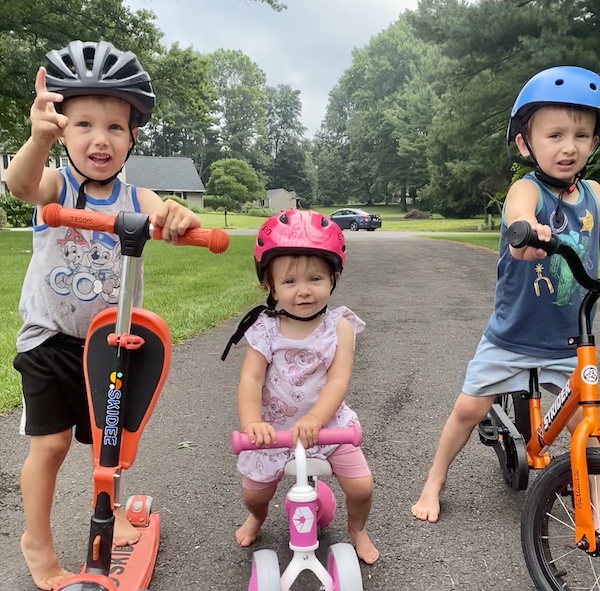
Not only do these helmets prioritize safety, but they also come in a variety of fun and stylish designs that will have your toddler excited to wear them. As a mom of three whose kids love to be moving I want to make sure they are safe while having the time of their lives.
In this Article:
- Summary of Toddler Helmets
- What Style of Helmet is Safest for Toddlers?
- What Does MIPS Technology Mean in a Toddlers Helmet?
- What to Look For When Buying a Toddler Helmet?
- What Size Helmet is Best for a 1 or 2 Year Old?
- How To Measure Your Toddler Head Circumference
- What is the Best Helmet Shape for a Toddler?
- What is the Difference Between a Toddler Skating Helmet and a Toddler Bike Helmet?
- How Often Should a Toddler Helmet be Replaced?
- The Best Toddler Skate Helmets for Boys and Girls
- The Best Toddler Helmet for Bike, Skate and Scooters
- The Best Toddler Bike Helmet for 1 Year Old
- The Best Bike Toddler Helmet for 2, 3 and 4 Year Old Boys and Girls
- Conclusion on Best Toddler Helmet
Disclosure: Some of the links below are affiliate links. This means that, at zero cost to you, I will earn an affiliate commission if you click through the link and finalize a purchase. Rest assured all products I suggest are products I have bought or would buy based on personal experience or through my network of other mommas.
Summary of Toddler Helmets
| Helmet | Category |
|---|---|
Triple Eight Lil 8 Helmet | Best Overall Toddler Skate Helmet |
Pro-Tec Classic Helmet | Best Lightest Toddler Skate Helmet |
S-One Mini Lifer Helmet | Runner Up Best Toddler Skate Helmet |
Nutcase Little Nutty Helmet | Best Toddler Skate and Bike Helmet |
Ouwoer Helmet | Runner Up Best Skate and Bike Toddler Helmet
|
Giro Scamp MIPS Helmet | Best 1 Year Old Bike Helmet |
Joovy Noodle Helmet | Best Lightest 1 Year Old Bike Helmet |
Giro Hale MIPS Helmet | Best 2, 3 & 4 Year Old Bike Helmet |
Bell Sidetrack MIPS Helmet | Runner Up Best 2, 3 & 4 Year Old Helmet |
What Style of Helmet is Safest for Toddlers?
When it comes to choosing a style of helmet for toddlers, the safest option is a multi-purpose helmet specifically designed for biking or skateboarding, depending on your child's interest. If your toddler scooters, bikes and skates you might do best with an all purpose helmet instead of a specific bike helmet.
Look for helmets that meet safety standards, which ensures they have undergone rigorous testing to provide adequate impact protection.
Additionally, helmets with MIPS (Multi-Directional Impact Protection System) technology offer an extra layer of safety by reducing rotational forces during an impact.
Lucky for us there are plenty of styling toddler helmets that are safe!
What Does MIPS Technology Mean in a Toddlers Helmet?
MIPS stands for Multi-Directional Impact Protection System. It is a technology integrated into certain helmets, primarily bike helmets, to provide an additional layer of protection against rotational forces during an impact. Rotational forces can occur during an angled impact, causing the head to rotate rapidly, potentially leading to brain injuries.
MIPS technology works by incorporating a low-friction layer inside the helmet. This layer allows the helmet to slide slightly relative to the head upon impact, mimicking the brain's own natural protection system. By reducing the rotational forces transmitted to the brain, MIPS technology aims to decrease the risk of brain injuries, such as concussions.
Helmets with MIPS technology are designed to provide enhanced safety for users by addressing the specific risks associated with rotational impacts. It is important to note that while MIPS can offer additional protection, it is still essential to ensure a proper fit and follow standard safety guidelines when using any helmet.
What to Look For When Buying a Toddler Helmet?
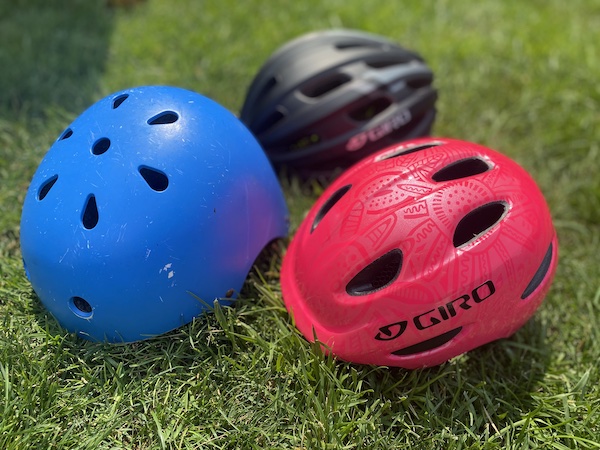
Proper Fit of Helmet
- The helmet should fit securely and snugly on your toddler's head without any wobbling or sliding. Look for helmets with adjustable sizing systems or fit dials to customize the fit as your child grows.
Safety Certifications
- Check for certifications like CPSC (Consumer Product Safety Commission) in the United States, which ensures the helmet meets safety standards for bike helmets and ASTM F1492 for skate helmets.
- Look for labels or stickers indicating compliance with recognized safety standards.
Size and Age Range
- Make sure the helmet is appropriate for your child's age and head size. Manufacturers often provide age and head circumference guidelines to help you select the right size.
Coverage and Protection
- Opt for helmets that provide ample coverage, including protection for the back of the head. Look for extended coverage and helmets designed specifically for the activity.
Ventilation
- Ensure the helmet has adequate ventilation to keep your toddler's head cool and comfortable during rides. Look for helmets with multiple vents or ventilation channels.
Adjustable Straps and Buckles
- Check for easily adjustable straps and buckles that secure the helmet in place. They should be easy to use and provide a secure and comfortable fit.
Padding and Comfort
- Look for helmets with sufficient padding inside for cushioning and comfort. The padding should be removable and washable for hygiene purposes.
Increased Visibility
- Consider helmets with reflective elements or bright colors to enhance visibility, especially when riding in low-light conditions.
Weight of Toddler Helmet
- Choose a lightweight helmet that won't strain your toddler's neck and make it uncomfortable to wear for extended periods.
Style and Design of Toddler Helmet
- While safety is paramount, finding a helmet with a design or style that your toddler likes can make wearing it more appealing and increase compliance.
- Remember, it's crucial to regularly inspect and replace a helmet if it has been involved in a significant impact or shows signs of damage.
What Size Helmet is Best for a 1 or 2 Year Old?
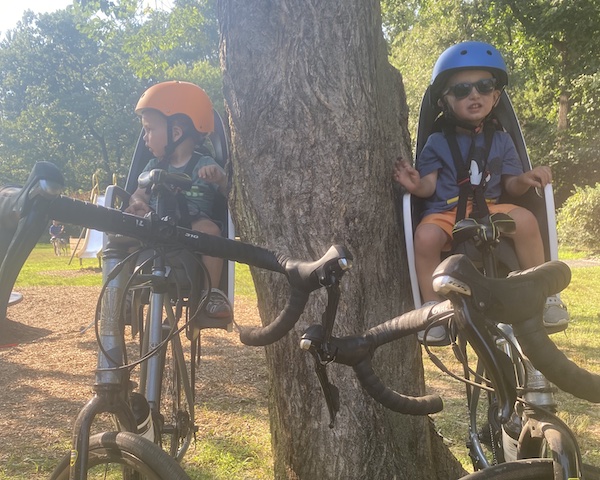
When choosing a helmet size for a 1 or 2-year-old, it's essential to consider their head circumference. The circumference of a child's head is the primary factor in determining the appropriate helmet size.
- Extra Small (XS): Typically fits head circumferences ranging from 44cm to 48cm (17.25 inches to 18.75 inches). This size is suitable for many 1-year-olds and some smaller 2-year-olds.
- Small (S): Generally fits head circumferences ranging from 48cm to 52cm (18.75 inches to 20.5 inches). This size is suitable for most 2-year-olds and some larger 1-year-olds.
However, it's crucial to note that head sizes can vary among children, so it's best to measure your child's head circumference before purchasing a helmet.
When trying on helmets, ensure a snug and secure fit without any excessive movement or gaps. The helmet should sit level on their head, covering the forehead, and the chin strap should be adjusted to keep the helmet in place.
How To Measure Your Toddler Head Circumference
To measure their head circumference, use a flexible measuring tape and wrap it around the widest part of their head, just above the eyebrows.
Read the number where the measuring tape meets. This is their current head circumference. Verify every 6 months to be safe.
Pro Tip: My toddlers always get their head circumference measured at the doctors during their check ups. If your toddler has recently had a check up you can use that for reference.
What is the Best Helmet Shape for a Toddler?
The best helmet shape for a toddler is one that provides full coverage and protection for the head, particularly the forehead and the back of the head. The key features to consider for an optimal helmet shape are:
- 1. Round Shape: Look for helmets with a rounded shape that conforms to the natural contours of a toddler's head. This helps ensure a secure and comfortable fit.
- 2. Extended Coverage: Choose a helmet with extended coverage at the back to provide additional protection for the occipital bone and the back of the head. This is especially important for toddlers who are still developing their balance and coordination skills.
- 3. Full Head Coverage: The helmet should cover the entire top of the head, including the forehead, without exposing any vulnerable areas.
- 4. Lowered Temple Coverage: Opt for a helmet with slightly lowered temple coverage to protect the sides of the head. This can be particularly beneficial for toddlers who may have a tendency to fall or lean to the side and skateboarding helmets.
- 5. Rounded Edges: Helmets with rounded edges are generally more comfortable and reduce the risk of sharp edges digging into the toddler's skin.
Additionally you want to consider the primary reason for the helmet.
Pro Tip: If you are cycling with your toddler in a bike seat you will want a toddler bike helmet with a flat back. A flat back helmet will rub less against the seat resulting in the helmet staying in place and not getting pushed forward.
What is the Difference Between a Toddler Skating Helmet and a Toddler Bike Helmet?
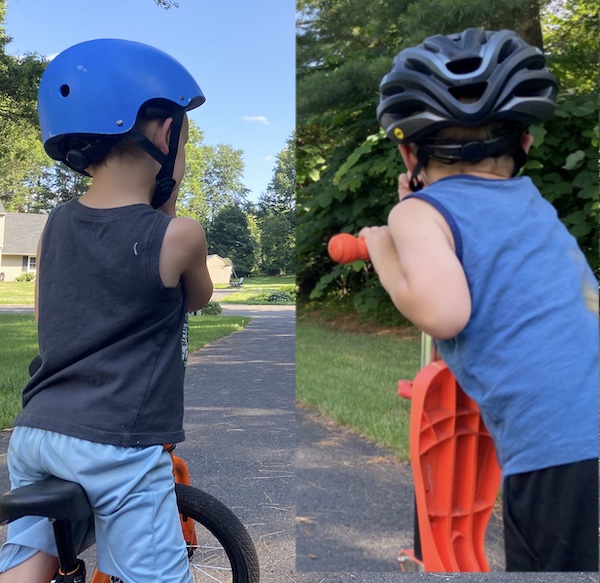
Skate helmets and bike helmets for toddlers differ in their design and features to cater to the specific needs of each activity. Here are the key differences between skate helmets and bike helmets for toddlers:
Skate Helmets Weigh and Cover More
- Skate helmets typically offer more coverage compared to bike helmets. They have a rounder and deeper shape, providing protection to a larger portion of the head, including the back and sides.
- This is because skateboarding poses a higher risk of falls and impacts from multiple directions.This results in a toddler skate helmet weighing more.
Skate Helmets are Designed for Multiple Impacts while Bike Helmets Designed for Only One
- Skate helmets are designed to withstand multiple impacts and offer higher impact protection. They often have a hard outer shell made of ABS plastic or a similar material, combined with an inner foam liner to absorb and distribute impact energy.
- Bike helmets are generally designed for single-impact protection and focus on absorbing the force of one major impact.
Bike Helmets Offer More Ventilation and Keeps Heads Cooler
- Bike helmets typically have more ventilation with larger vents to promote airflow and keep the head cool during cycling.
- Skate helmets, on the other hand, may have fewer and smaller vents, as skateboarding involves less intense physical exertion and typically takes place in shorter bursts.
Skate Helmets Typically Are More Adjustable and Customizable
- Skate helmets often have a more adjustable fit system, including adjustable straps and sometimes an additional padding kit for customization. This allows for a snug and secure fit, which is important for the helmet to stay in place during skateboarding tricks and maneuvers.
- Bike helmets, while still adjustable, may have a simpler fit system as the focus is primarily on comfort and stability during cycling.
Skate Helmets and Bike Helmets have Different Safety Certifications
- Skate helmets may comply with ASTM F1492, which is specific to skateboarding and trick roller skating
- Bike helmets comply with CPSC (Consumer Product Safety Commission) certification for cycling safety.
When choosing a helmet for your toddler, consider the specific activity they will be engaged in, whether it's skateboarding, biking, or both.
How Often Should a Toddler Helmet be Replaced?
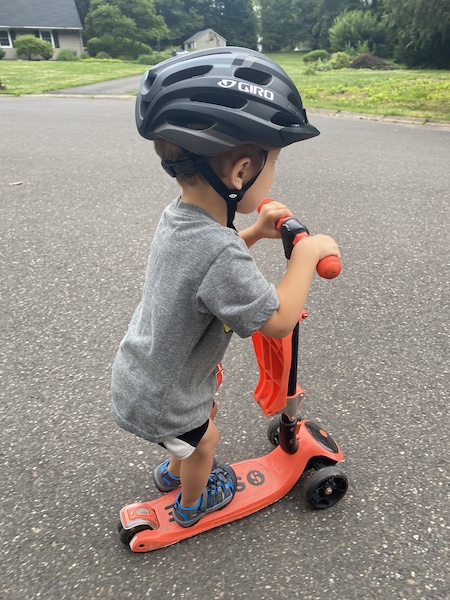
Toddlers grow quickly, and their helmet needs may change as they develop. In addition, helmets can experience wear and tear over time, potentially impacting their effectiveness. Therefore, it is generally recommended to replace a toddler's helmet in the following situations:
Growth of your Toddler's Head
- As your toddler grows, their head size may change, requiring a larger helmet.
- If the helmet becomes too small or does not fit correctly, it's time to replace it with a larger size.
My personal experience was a helmet sized for my 1 year old fit for a year and a half before I had to size up. However, a 3 year old helmet will last longer. Remember the younger the toddler the quicker their head will be growing.
Significant Impact from a Crash or Fall
- If the helmet has been involved in a significant impact or accident, it should be replaced, even if there are no visible signs of damage.
- Helmets are designed to absorb impact and protect against a single event.
- After a crash, the structural integrity of the helmet may be compromised, making it less effective in subsequent impacts.
Damage and Wear
- Regularly inspect the helmet for any signs of damage, such as cracks, dents, or frayed straps.
- If you notice any significant damage or wear, it is advisable to replace the helmet, as it may not provide the same level of protection as a new one.
Helmet Age and Usage
- Manufacturers typically recommend replacing helmets every three to five years, even if there are no visible signs of damage.
- Over time, the materials may degrade or become less effective at absorbing impacts.
As a mom that means not reusing helmets, once one child outgrows a helmet I dispose of it.
Remember, the safety of your toddler is paramount, and a well-fitting and undamaged helmet is crucial for protecting their head during activities.
The Best Toddler Skate Helmets for Boys and Girls
Choosing the best toddler skate helmet depends on several factors, including fit, safety features, comfort, and personal preference. A toddler skate helmet weighs more than a toddler bike helmet due to a larger protection area and designed for multiple impacts.
Skate Helmets are great for toddlers who skateboard, rollerblade, or scooter.
Triple Eight Lil 8 Dual Certified Sweatsaver Helmet
- Weight: 509 grams
- This helmet is designed specifically for toddlers and kids up to 5. It offers dual certification for both skateboarding and biking.
- It features a durable ABS shell, soft Sweatsaver lining for comfort, adjustable straps, pinch saver pad and a range of playful designs.
- The helmet comes with different thickness liners to ensure a great fit with your toddler.
This is a great toddler skate helmet for both a girl and boy!
Pro-Tec Classic Certified Skate Helmet
- Weight: 500 grams
- The Pro-Tec Classic Certified Skate Helmet is known for its reliable protection and timeless style and is also the lightest of my top picks.
- It is dual-certified for skateboarding and biking and features a durable ABS shell, comfortable foam padding, adjustable straps, and multiple vents for breathability.
S-ONE Mini Lifer Helmet
- 630 grams
- The S-ONE Lifer CPSC helmet is a popular choice among skateboarders of all ages, including toddlers. It is made with a high-density EPS foam liner that provides excellent multi impact protection. The helmet is dual-certified CPSC and ASTM, has a snug fit, and comes in various vibrant colors.
- Sizes range from x-small (18.5 cm) to large (20.5 cm) before moving up to the S-One Lifer Helmet for more kid sizes.
- The big drawback is it is the heaviest skate helmet.For this reason, I would recommend it for an older toddler of 3 or 4.
Remember, when choosing a skate helmet for your toddler, it's crucial to ensure the proper fit by following the manufacturer's size guidelines and adjusting the straps accordingly. Additionally, always prioritize safety certifications to ensure the helmet meets the necessary standards for impact protection.
The Best Toddler Helmet for Bike, Skate and Scooters
Nutcase Little Nutty Helmet
- 540 grams : heaver than bicycle helmets
- While originally designed for biking, the Nutcase Little Nutty Street Bike Helmet is also suitable for skateboarding. The toddler size, a head circumference of 48-52cm makes it a great 2 year old helmet.
- It offers excellent head coverage, a comfortable fit system, adjustable straps, and comes in a wide range of fun and eye-catching designs. Your toddler, whether boy or girl, will have fun picking one out.
- It features a magnetic closure, a pinch free (cry free) closure.
Nutcase Bike helmet has a harder shell (ABS shell) than the typical bike helmet and a larger head coverage makes it perfect as a combo helmet for skateboarding as well. However, this helmet won’t provide as much ventilation as other bike helmets and weighs more than most toddler bike helmets.
OUWOER Kids Bike Helmet
- The Ouwoer Kids Bike helmet in size small (48-54cm) fits most toddlers as young as one at one of the more affordable prices. My middle child had a large head and this helmet initially fit him great. It comes with sets of pads to further fit the helmet to your toddlers head.
- This helmet was made for multi sports with its EPS thick foam providing shock-absorbency.
- Satisfies the safety requirements and comes in many solid colors; I have blue and orange.
- The one downside of this helmet I found is if your child has a more long or oval shaped head the fit isn’t great. One of my children has an elongated egg shaped head and this helmet doesn’t fit great. For my other two children with more rounded heads I have no concern.
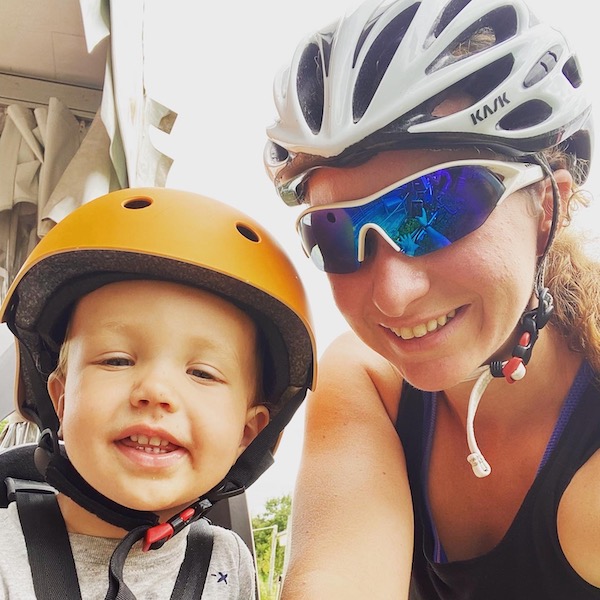 My son in the Ouwoer bike helmet in rear bike seat
My son in the Ouwoer bike helmet in rear bike seat
This helmet is a great option if your toddler will be doing a bit of everything including riding on the back of your bike. It has a smooth back for a comfortable position when leaning against their rear bike seat.
The Best Toddler Bike Helmet for 1 Year Old
Often a 1 year old’s head circumference is too small to fit most toddler bike helmets, unless your 1 year old is in the top percentile for head circumference. Both my boys were, however my daughter was not.
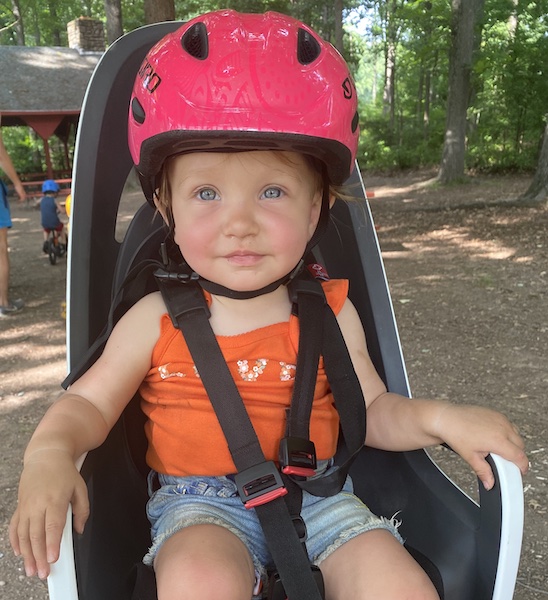
For a 1 year old helmet you want a lightweight helmet that accommodates the smaller heads.
Giro Scamp MIPS Youth Recreational Cycling Helmet
- 251 grams
- The Giro Scamp helmet comes in an extra small size, accommodating a head circumference of 45-49cm. This will fit most one year old’s head circumference and works great for my daughter.
- The Giro Scamp was specifically designed for 1 to 4 year olds and satifies bike safety requirements.
- Features MIPS technology, adjustability, comfortable fit, pinch-guard buckle and built in visor.
A great toddler girl helmet selection with its ponytail compatibility. Also comes in fun boy designs making it a great for either gender. Further the back of the helmet is round and smooth making it a great helmet to wear when riding in a rear bike seat!
Joovy Noodle Helmet
- 226 grams
- The Joovy Noodle Helmet is a versatile option suitable for a wide range of outdoor activities.
- Durable and shock-absorbent construction offers reliable protection, while the adjustable fit dial ensures a snug and secure fit.
- Additional features multiple air vents to keep your toddler cool and comfortable, even on hot summer days.
- It is available in various playful colors, the Joovy Noodle Helmet is compliant with all safety requirements.
This helmet works great for 1 year old. The smallest size accommodates head circumference of 44-50 cm and is super lightweight.
The Best Bike Toddler Helmet for 2, 3 and 4 Year Old Boys and Girls
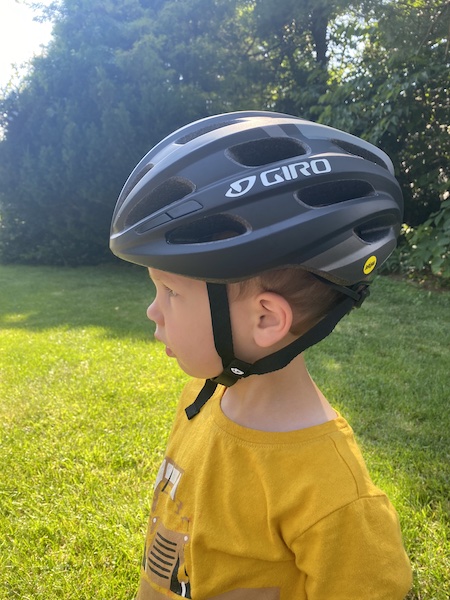
A great bike helmet for 2, 3, and 4 year old will meet all safety requirements as a minimum. MIPS, adjustability and lightweight are other top qualities you are looking for in a toddler helmet. Below are the top choices to select from.
Giro Hale MIPS Helmet
- 259 grams
- The Giro Hale MIPS Helmet satisfies all toddler safety requirements
- Features MIPS technology, which provides additional protection against rotational forces, this helmet offers an extra layer of safety for your little one
- Its super lightweight construction, comfortable fit, and a wide range of vibrant colors and patterns make it a popular choice for 2, 3 and 4 year olds
- My only downside is that it comes in a standard buckle. You do have to watch not to pinch your toddler when securing the helmet, however that does make it more affordable.
This is a great toddler helmet for 2, 3 and 4 year olds. My son, aged 3, wears this helmets and the fit is exceptional.He has an elongated head, and most helmets don’t fit his head well. This helmet supports his less rounded head shape and keeps him safe. I highly recommend this helmet for toddlers with more egg shaped heads.
Bell Sidetrack MIPS Youth Bike Helmet
- 310 grams
- The Bell Sidetrack MIPS Youth Bike Helmet is another fantastic option designed specifically for toddlers, size universal toddler.
- Durable construction and extended rear coverage, it offers excellent head protection during biking adventures.
- The MIPS technology reduces the risk of head injuries, while the adjustable fit system ensures a snug and secure fit as your child grows.
- The helmet comes in a handful of fun colors and patterns. Let your toddler pick their favorite! I personally love the yellow orange combo!
- Downside: it is a heavier helmet when compared to the Giro Hale, but still less than skateboarding helmets.
Conclusion on Best Toddler Helmet
When it comes to ensuring our toddlers' safety during outdoor activities, investing in a high-quality helmet is non-negotiable. The helmets listed above excel in both safety features and appealing designs, providing you with peace of mind while your little one explores the world.
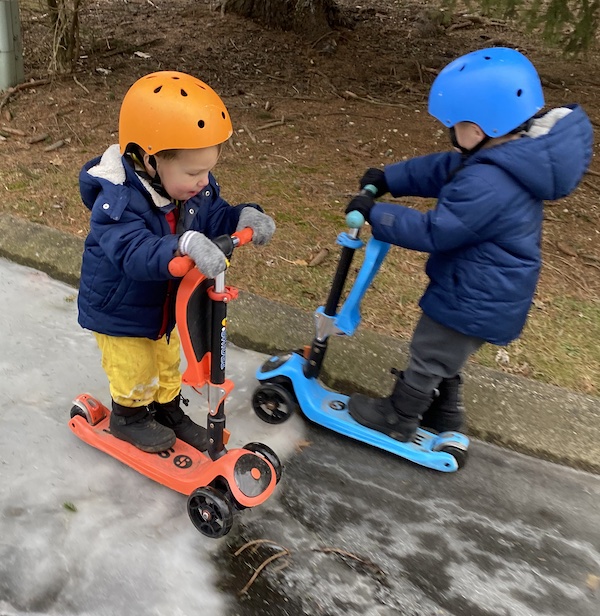
Remember, a helmet should fit properly, be comfortable to wear, and offer the necessary protection. By choosing any of these top-rated toddler helmets, you can prioritize safety without compromising on style, giving your child the perfect combination of protection and personal flair.
Gear up, and let the adventures begin with the best toddler helmets on the market!









